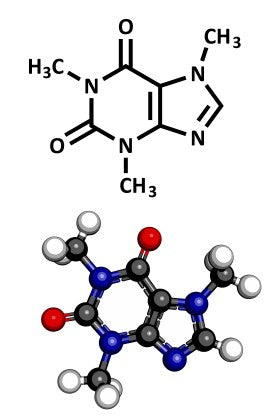Theacrine, also known as Chinese bitter tea, Kucha, 1, 3, 7, 9-tetramethyluric acid, TeaCrine and TeaCor, is found in Camellia Kucha Tea Leaves and Cupuaçu (Theobroma grandiflorum).
[1][2] Theacrine is a purine alkaloid molecule with a similar chemical structure to caffeine, which means it exhibits stimulant properties when ingested because it crosses the blood-brain barrier and binds to adenosine and dopamine receptors.
[3]The Kucha tea plant leaves create theacrine through a 2-step process. While still developing, the plant first converts theobromine in to caffeine and then converts theobromine and caffeine in to theacrine.
[4] Compared to mature leaves, young Kucha tea plant leaves contain higher concentrations of both theacrine (1.3-3.6% of dry weight) and caffeine (0.6-2.7% of dry weight).
[2][5] For example, a 2 gram teabag containing Kucha tea leaves may only yield 20.8-57.6mg of theacrine.
[6]Because there's a much smaller amount of research on Cupuaçu, the theacrine content by weight has not yet been identified.
Theacrine is gaining popularity in the fitness industry due to its stimulant, anti-inflammatory and analgesic properties. Both Camellia Kucha Tea Leaves and Cupuaçu are naturally low in theacrine so supplement companies extract and refine theacrine from these sources so that it can be offered in a more concentrated, bioavailable and cost-effective form.
Theacrine Recommended Dosages & Use

Consider Theacrine to be a longer-lasting version of our favorite stimulant, caffeine.
Theacrine is most commonly found in supplements advertised as pre-workouts and fat burners. There is currently no standard dose quantity and frequency for theacrine, but one manufacturer suggests 200 to 300 milligrams to maximize its benefits without side effects. [1]
Since theacrine exhibits stimulant properties, it's recommended to those looking to increase their energy, alertness and locomotion. Theacrine is a good alternative to caffeine as well as banned synthetic stimulants like DMAA (1,3-dimethylamylamine), AMP citrate (4-amino-2-methylpentane citrate) and 1,3-DMBA (1,3-Dimethylbutylamine HCL). [1] Theacrine appeals to all fitness demographics - those looking to increase muscle, increase strength, improve athletic performance, or decrease fat mass.
A Deeper Look at Theacrine Benefits
Unfortunately, most studies examining theacrine exam mice rather than human subjects, but if the results below are any indication of theacrine s potential, then it's just a matter of time before the number of human studies examining theacrine increases.
Theacrine increases locomotion (re: activity levels) by acting on both the adenosinergic and dopaminergic systems. Researchers injected rats with 0, 24, or 48mg of theacrine per kilogram of bodyweight and found that those administered the highest dose significantly increased activity levels compared to rats in the control group.
[3]We should expect activity levels to increase as stimulant dosages increase. The activity levels of rats administered 48mg/kg of bodyweight not only remained high throughout the entire session but these rats also did not exhibit theacrine tolerance after 7 days of chronic exposure.
[3]This gives theacrine the edge over
caffeine which typically leads to a tolerance of and reliance on caffeine after 7 days of chronic exposure. After 7 days of caffeine exposure, mice activity levels decreased by 26% whereas 7 days of theacrine exposure led to a 167% increase in activity levels.
[6][3]Oral ingestion of theacrine exhibits both anti-inflammatory and analgesic (re: pain relief) properties in mice. 8 to 32 milligrams of theacrine per kilogram of bodyweight decreased inflammation markers (measured by xylene-induced ear edema, ?-Carrageenan-induced paw edema, and vascularity permeability) as well as increased the pain tolerance (measured by acetic-acid induced writhing and pain threshold during hot-plate exposure).
[7]
Theacrine has the edge over caffeine which typically leads to a tolerance of and reliance on caffeine after 7 days of chronic exposure.
Theacrine appears to be an effective compound for those looking to decrease muscular inflammation, pain, and discomfort. Comparatively, oral ingestion of 8 to 32mg of caffeine per kilogram of bodyweight did not decrease inflammation markets or increase pain tolerance.
[6]Researchers fed mice 0, 3, 10, or 30mg of theacrine per kilogram of bodyweight for 7 consecutive days and found that theacrine also exhibits antidepressant properties. They measured antidepressant effects using a tail suspension test, forced swimming test, ambulatory activity test, yohimbine-induced toxicity test, reserpine test and 5-HTP (5-Hydroxytryptophan) induced head-twitching test.
Compared to the control group, theacrine shortened the immobility time in the tail suspension test, enhanced locomotion during the forced swimming test, but decreased the yohimbine consumption toxicity threshold and increased head-twitching induced by 5-HTP.
[8] Theacrine appears to be an effective compound for those undergoing activities that decrease central nervous system function.
Oral ingestion of theacrine exhibits anti-stress properties, specifically in mice with restraint stress-provoked liver damage (measured by plasma levels of alanine aminotransferase (ALT) and aspartate aminotransferase (AST)). Researchers fed mice 10, 20, or 30mg of theacrine per kilogram of bodyweight for 7 consecutive days and found that theacrine decrease plasma ALT and AST levels, reduced mRNA inflammatory markers, reversed tissue damaged, and increased oxygen radical absorbance capacity (ORAC) levels.
[9] Theacrine appears to be an effective compound for those looking to modulate the stress response during high-stress situations.
Theacrine Side Effects

The current research does not indicate significant negative side effects from consuming Theacrine at dosages of 200 to 300mg. One study examining the LD50 of theacrine in mice (re: individual dose required to kill 50% of a test animal population) found that an average acute oral dose of 810.6mg/kg of bodyweight is required. [7] For a 180lb male, this equates to about 66 grams of theacrine, which is nearly impossible to consume.
Kucha tea, a natural source of theacrine, has been consumed in China for thousands of years without any seriously reported side effects. [1] However, one study on mice found that high doses of theacrine decreased the yohimbine consumption toxicity threshold and increased head-twitching induced by 5-HTP in mice. [7] A decreased toxicity threshold indicates that less yohimbine was required to reach toxicity compared to the control group and the increased head twitching is likely due to how theacrine acts on gamma-Aminobutyric acid (GABA) receptors.
Another study found that theacrine increased sleeping time after mice were injected with pentobarbital, a short-acting barbiturate. [10] However, we should not jump to the conclusion that theacrine has potent sedative and hypnotic properties based on what the study suggests. Given the plethora of benefits and minimal significant side effects, there's no reason not to include Theacrine in your supplement arsenal.
Theacrine FAQs
Where can I find Theacrine today?
When this article was written, there was only one retailer that sold Theacrine as a stand-alone product. However, this product is quickly gaining popularity as a potent ingredient in pre-workouts and fat burners. Products that contain Theacrine include:
-
Purus Labs Theatrim - contains TeaCrine, which is Nature-Identical Theacrine. The exact amount is unlisted but it's the 2nd ingredient in a 278mg proprietary blend that also includes dicaffeine malate and caffeine).
- 4th Generation Cellucor C4 - contains TeaCor, which is the patent-pending version exclusively distributed by Compound Solutions, Inc. the exact amount is unlisted but it's the 4th of 4 ingredients in a 371mg proprietary blend. There is 150mg of caffeine which is the second most abundant ingredient in the proprietary blend.
- VPX Sports MD2 Meltdown - contains Theacrine as the 2nd ingredient in a 464mg proprietary blend comprised of 7 ingredients. The most abundant ingredient in the proprietary blend, caffeine, comprises 325mg of the 464mg.
- Omega Sports Shred XT - contains 1,000mg of camellia kuccha tea leaves standardized for 5% theacrine, which equates to 50mg of active theacrine.
Is Theacrine safe to stack with other supplements?
The research thus far indicates that Theacrine is extremely safe to use as a standalone product or stack with other supplements. Since theacrine contains stimulant properties and is an alkaloid similar chemical in structure to caffeine, you should minimize and/or closely monitor your intake of additional stimulant sources.
Consuming too many stimulants can negatively impact your health and gym performance. If you have pre-existing medical conditions then it's important you check with your health care professional before consuming theacrine. However, for a healthy individual with no pre-existing medical conditions Theacrine appears to be a promising supplement to improve both athletic performance and burn fat.
References
1) "Theacrine (extracted from Camellia Assamica variant kucha)." Herb Nutritionals Co., Ltd. N.p., 2014.2) Zheng, XQ, et al. "Theacrine (1,3,7,9-tetramethyluric Acid) Synthesis in Leaves of a Chinese Tea, Kucha (Camellia Assamica Var. Kucha)." National Center for Biotechnology Information. Phytochemistry, May 2002.3) Feduccia, AA, et al. "Locomotor Activation by Theacrine, a Purine Alkaloid Structurally Similar to Caffeine: Involvement of Adenosine and Dopamine Receptors." National Center for Biotechnology Information. Pharmacol Biochem Behav., Sept. 2012.4) Petermann, Joseph B., and Thomas W. Baumann. ?Metabolic Relations between Methylxanthines and Methyluric Acids in Coffea L. .? Plant Physiology 73.4 (1983): 961?964.5) Moussa, Adel. "Lack of Drive? Theacrine Will Get You Going - Every Day! Camellia Kucha Alkaloid Acts via Dopamine and Adenosine." SuppVersity - Nutrition and Exercise Science for Everyone. N.p., May 2012.6) Ball, KT, and A. Poplawsky. "Low-dose Oral Caffeine Induces a Specific Form of Behavioral Sensitization in Rats." National Center for Biotechnology Information. Pharmacol Rep., 2011.7) Wang, Y., et al. "Theacrine, a Purine Alkaloid with Anti-inflammatory and Analgesic Activities." National Center for Biotechnology Information. Fitoterapia, Sept. 2010.8) Xie, Guo, et al. "Experimental Study of Theacrine on Antidepressant Effects." Chinese Pharmacological Bulletin. N.p., Sept. 2009.9) Li, WX, et al. "Theacrine, a Purine Alkaloid Obtained from Camellia Assamica Var. Kucha, Attenuates Restraint Stress-provoked Liver Damage in Mice." National Center for Biotechnology Information. J Agric Food Chem, July 2013.10) Xu, JK, et al. "Theacrine, a Special Purine Alkaloid with Sedative and Hypnotic Properties from Cammelia Assamica Var. Kucha in Mice." National Center for Biotechnology Information. J Asian Nat Prod Res., Dec. 2007.



